Critical Art Ensemble (1994-2006)
Filed under book | Tags: · activism, art, biotechnology, control society, copyright, cultural resistance, tactical media, transgenics, virtuality
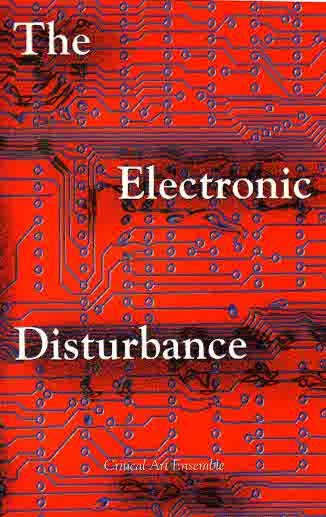
The Electronic Disturbance (1994)
The Critical Arts Ensemble is a virtual collective. This collection of essays and short pieces examines the changing rules of cultural and political resistance: “The current technological revolution has created a new geography of power relations — as data, human beings confront an authoritarial impulse that thrives on absence. As a virtual geography of cognizance and action, resistance must assert itself in electronic space.”
Publisher Autonomedia, May 1994
ISBN 1570270066

Electronic Civil Disobedience and Other Unpopular Ideas (1997)
In the age of global, nomadic capital, the CAE attempts to lay the foundation for the growth of nomadic resistance. Utilizing the tools of its enemy, the CAE suggests that a new cultural and political resistance is possible. Fusing a situationist-influenced concept of contestational art, an understanding of the parallel nature of cultural and political action borrowed from Gramsci, and a hacker’s deep understanding of how new technology functions, ECD is a launch point for debating the nature of power and resistance in the information age.
Publisher Autonomedia, May 1997
ISBN 9781570270567
commentary (Stefan Wray)
authors
publisher
PDF
View online, cont. (La Résistance électronique et autres idées impopulaires, French)
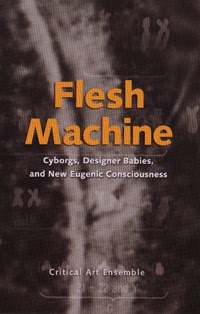
Flesh Machine: Cyborgs, Designer Babies, and New Eugenic Consciousness (1998)
Having elsewhere explored the dimensions of social and political control in electronic culture, the Critical Arts Ensemble here turns full frontal towards the body, arguing that utopian promises of virtuality are simple distractions from the real project: the deployment of biotechnologies upon the bodies of citizens in the service of the transnational order.
Publisher Autonomedia, March 1998
ISBN 9781570270673
PDF
PDF (Η μηχανή της σάρκας: Εκδόσεις των ξένων, Greek)
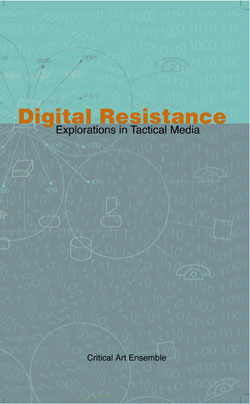
Digital Resistance: Explorations in Tactical Media (2000)
Essays in cultural politics and technology from the collective authors of Electronic Disturbance, Electronic Civil Disobedience and Flesh Machine. Chapters in this new volume include “Electronic Civil Disobedience and the Public Sphere,” “The Mythology of Terrorism on the Net,” “The Promissory Rhetoric of Biotechnology,” “Observations on Collective Cultural Action,” “Recombinant Theater and Digital Resistance,” “Contestational Robotics,” “Children as Tactical Media Participants,” and “The Financial Advantages of Anti-Copyright.”
Publisher Autonomedia, April 2000
ISBN 1570271194
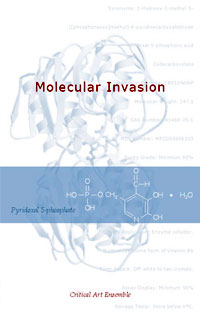
The Molecular Invasion (2002)
Having exhausted the possibilities for geographic colonial expansion, as well as reaching the fiscal limitations of virtual space, capital begins its invasion of a new frontier — organic molecular space. The Critical Art Ensemble began mapping this development in Flesh Machine (Autonomedia, 1998) by examining the use of reproductive technologies and their promise for achieving an intensified degree of control over worker and citizen. The Molecular Invasion acts as a companion to this first book by mapping the politics of transgenics, and offering a model for the creation of a contestational biology, as well as providing direct interventionist tactics for the disruption of this new assault on the organic realm.
Publisher Autonomedia, April 2002
ISBN 1570271380, 9781570271380
140 pages
PDF
PDF (Molekularna invazija, Croatian)
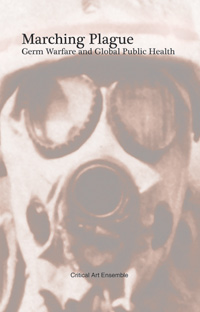
Marching Plague: Germ Warfare and Global Public Health (2006)
The sixth Critical Art Ensemble book offers a radical reframing of the rhetoric surrounding germ warfare. After refuting the idea that massive biological attack is a probable future occurrence, the book goes on to argue that biological weapons programs primarily serve the economic interests of the military-security complex, squandering resources needed to fight the massive loss of life each year from emerging infectious diseases. The book also includes two appendices examining the case of the U.S. Justice Department against Steve Kurtz, for which the original manuscript of the book was seized in the state’s investigation.
Publisher Autonomedia, 2006
ISBN 157027178X, 9781570271786
148 pages
review (Randall Packer)
authors
publisher
Joanna Zylinska: Bioethics in the Age of New Media (2009)
Filed under book | Tags: · bio art, bioethics, biopolitics, biotechnology, ethics

Bioethical dilemmas—including those over genetic screening, compulsory vaccination, and abortion—have been the subject of ongoing debates in the media, among the public, and in professional and academic communities. But the paramount bioethical issue in an age of digital technology and new media, Joanna Zylinska argues, is the transformation of the very notion of life. In this provocative book, Zylinska examines many of the ethical challenges that technology poses to the allegedly sacrosanct idea of the human. In doing so, she goes beyond the traditional understanding of bioethics as a matter for moral philosophy and medicine to propose a new “ethics of life” rooted in the relationship between the human and the nonhuman (both animals and machines) that new technology prompts us to develop.
After a detailed discussion of the classical theoretical perspectives on bioethics, Zylinska describes three cases of “bioethics in action,” through which the concepts of “the human,” “animal,” and “life” are being redefined: the reconfiguration of bodily identity by plastic surgery in a TV makeover show; the reduction of the body to two-dimensional genetic code; and the use of biological material in such examples of “bioart” as Eduardo Kac’s infamous fluorescent green bunny.
Zylinska addresses ethics from the interdisciplinary perspective of media and cultural studies, drawing on the writings of thinkers from Agamben and Foucault to Haraway and Hayles. Taking theoretical inspiration in particular from the philosophy of alterity as developed by Jacques Derrida, Emmanuel Levinas, and Bernard Stiegler, Zylinska makes the case for a new nonsystemic, nonhierarchical bioethics that encompasses the kinship of humans, animals, and machines.
Published by MIT Press, 2009
ISBN 0262240564, 9780262240567
240 pages
Key terms: bioethics, biopolitical, Stelarc, Homo Sacer, bioart, Jacques Derrida, Bernard Stiegler, Giorgio Agamben, Emmanuel Levinas, cybernetics, Peter Singer, ethics, Michel Foucault, Eugene Thacker, Cyborgs, moral panics, biopower, biotechnology, Cultural Studies
PDF (updated on 2012-7-25)
Comment (0)Eugene Thacker: Biomedia (2004)
Filed under book | Tags: · autopoiesis, bioethics, bioinformatics, biotechnology, genetics, nanotechnology, posthuman, systems theory

As biotechnology defines the new millennium, genetic codes and computer codes increasingly merge-life understood as data, flesh rendered programmable. Where this trend will take us, and what it might mean, is what concerns Eugene Thacker in this timely book, a penetrating look into the intersection of molecular biology and computer science in our day and its likely ramifications for the future.
Integrating approaches from science and media studies, Biomedia is a critical analysis of research fields that explore relationships between biologies and technologies, between genetic and computer “codes.” In doing so, the book looks beyond the familiar examples of cloning, genetic engineering, and gene therapy-fields based on the centrality of DNA or genes-to emerging fields in which “life” is often understood as “information.” Focusing especially on interactions between genetic and computer codes, or between “life” and “information,” Thacker shows how each kind of “body” produced-from biochip to DNA computer-demonstrates how molecular biology and computer science are interwoven to provide unique means of understanding and controlling living matter.
Throughout, Thacker provides in-depth accounts of theoretical issues implicit in biotechnical artifacts-issues that arise in the fields of bioinformatics, proteomics, systems biology, and biocomputing. Research in biotechnology, Biomedia suggests, flouts our assumptions about the division between biological and technological systems. New ways of thinking about this division are needed if we are to understand the cultural, social, and philosophical dimensions of such research, and this book marks a significant advance in the coming intellectual revolution.
Publisher University of Minnesota Press, 2004
ISBN 0816643520, 9780816643523
226 pages
Key terms: bioinformatics, bioMEMS, nanomedicine, DNA computer, bioethics, systems biology, nanotechnology, base pair, molecular biology, biotechnology, biocomputing, DNA chip, systems theory, posthuman, autopoiesis, bio-ethics, proteomics, programmable matter, wet lab, Bertalanffy
PDF (updated on 2013-3-16)
Comment (0)
